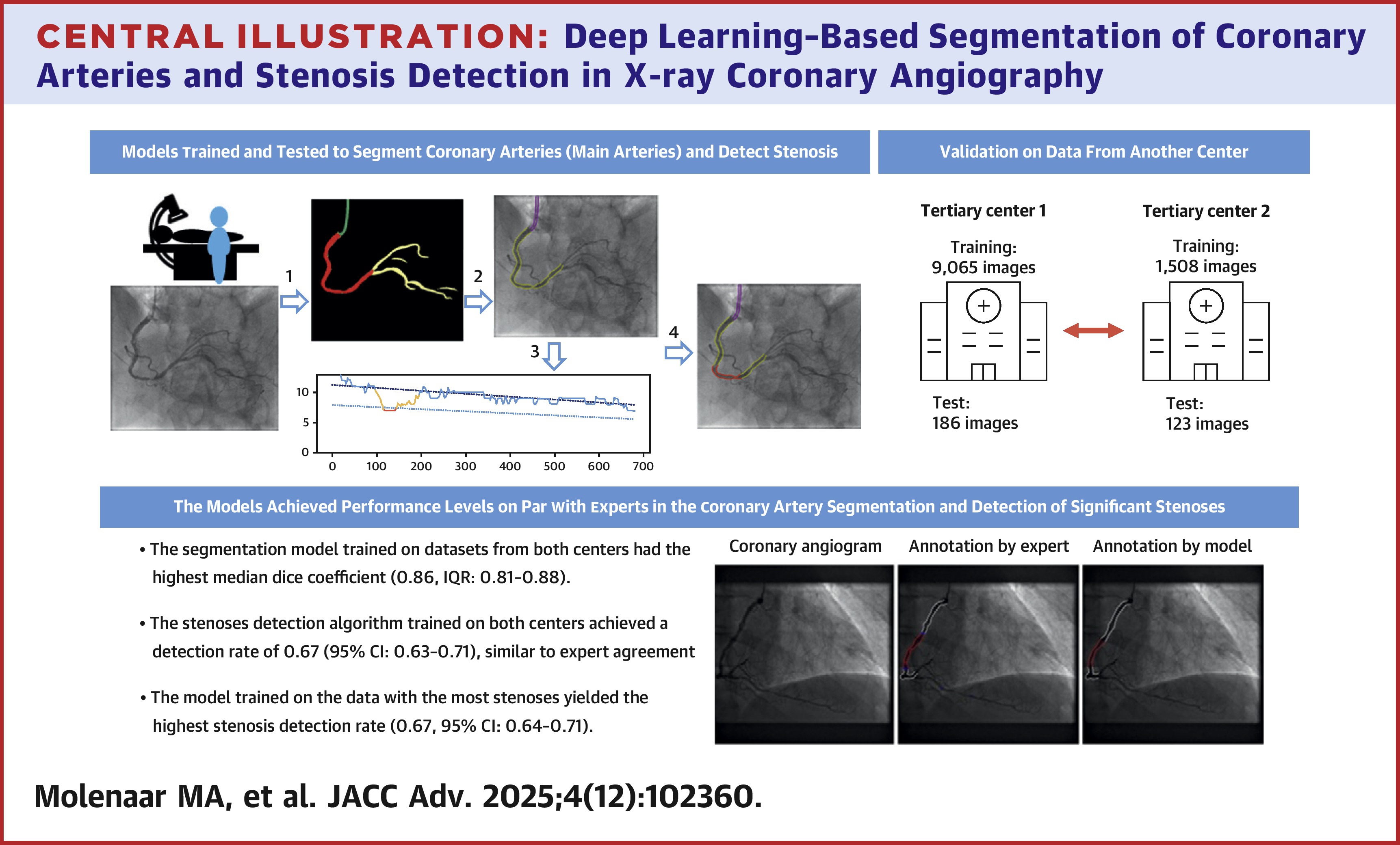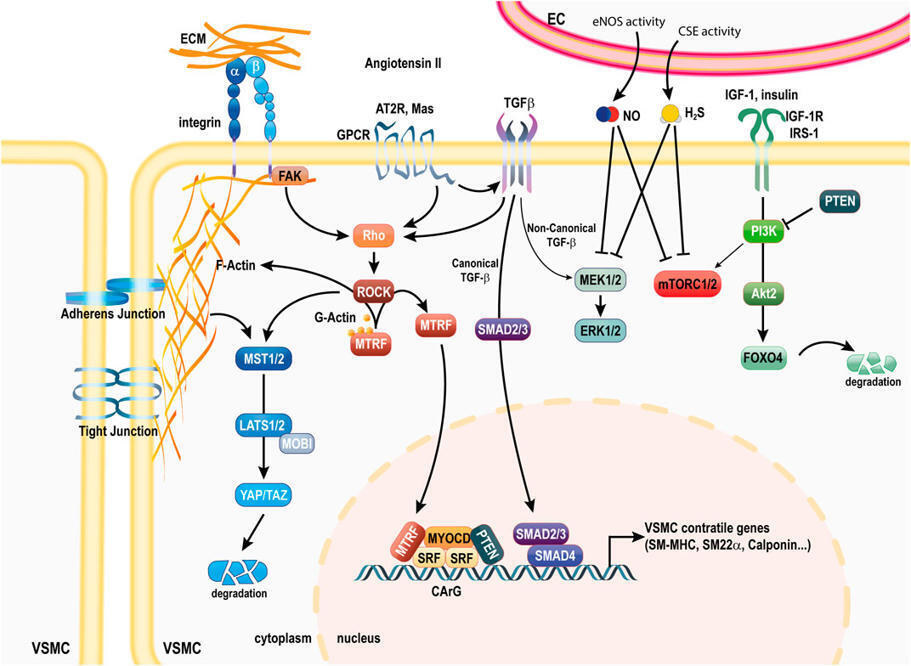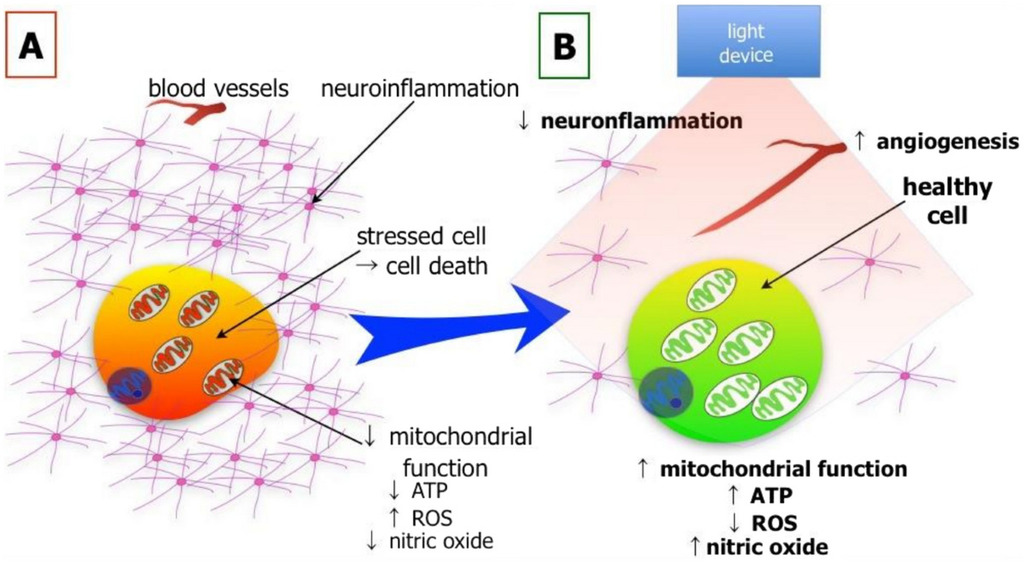
Deep Learning–Based Segmentation of Coronary Arteries and Stenosis Detection in X-Ray Coronary Angiography
www.jacc.org
Jan. 8, 2026, 11:28 a.m.
Deep learning applications may assist in automatically detecting coronary arteries on invasive coronary angiography (ICA).
Share on

Vascular Smooth Muscle Cell Proliferation in Restenosis
www.ahajournals.org
Jan. 8, 2026, 11:27 a.m.
Smooth muscle proliferation and migration after percutaneous intervention represent the end result of natural healing processes triggered by vascular injury. Vascular smooth muscle cell proliferation, especially after stent implantation, plays a critical role in neointimal hyperplasia through cellular expansion and extracellular matrix deposition. Elucidating the molecular mechanisms responsible for smooth muscle cell proliferation has led to the development of novel therapeutic approaches, including rapamycin- and paclitaxel-eluting stents that have significantly improved the care of patients with coronary artery disease. To address the concerns about the potentially increased incidence of stent thrombosis in patients treated with drug-eluting stents, newer stents and coronary devices have been developed such as drug-eluting stents with biodegradable polymers, drug-eluting stents that are polymer-free, stents with novel coatings, completely biodegradable stents, bifurcation stents, and drug-eluting balloons.
Share on

PDGF-induced proliferation in human arterial and venous smooth muscle cells: Molecular basis for differential effects of PDGF isoforms
onlinelibrary.wiley.com
Jan. 8, 2026, 11:25 a.m.
Platelet-derived growth factor (PDGF) has been implicated in the pathogenesis of arterial atherosclerosis and venous neointimal hyperplasia. We examined the effects of PDGF isoforms on smooth muscle cells (SMCs) from arterial and venous origins in order to further understand the differential responsiveness of these vasculatures to proliferative stimuli. Serum-starved human arterial and venous SMCs exhibited very different proliferative responses to PDGF isoforms. Whereas, proliferation of arterial SMCs was strongly stimulated by PDGF-AA, venous SMCs showed no proliferative response to PDGF-AA, but instead demonstrated a significantly greater proliferative response to PDGF-BB than arterial SMCs. Part of this difference could be attributed to differences in PDGF receptors expression.
Share on

Role of Platelets in Restenosis After Percutaneous Coronary Revascularization
www.jacc.org
Jan. 8, 2026, 11:09 a.m.
Platelets play an important role in the restenosis process after balloon angioplasty. Early experimental studies highlighted this role. Thrombocytopenia inhibits the intimal hyperplasia after arterial injury, provided it is established well before the time of injury and is sustained. Previous experimental studies and clinical trials testing antiplatelet drugs have been disappointing, suggesting that new and more powerful agents, such as the GP IIb/IIIa antagonists, may be required. These agents represent new hope to reduce restenosis after coronary angioplasty, as suggested by 6 months of follow-up in the EPIC study.
Share on

The functional role of platelets in the regulation of angiogenesis
www.tandfonline.com
Jan. 8, 2026, 11:07 a.m.
Platelets possess an armory of pro- and anti-angiogenic proteins, which are actively sequestered and highly organized in α-granule populations. Platelet activation facilitates their release, eliciting potent angiogenic responses through mechanisms that appear to be tightly regulated. In conjunction, the release of platelet-derived phospholipids and microparticles has also earned merit as synergistic regulators of angiogenesis. Consequently, platelets have been functionally implicated in a range of angiogenesis-dependent processes, including physiological roles in wound healing, vascular development and blood/lymphatic vessel separation, whilst facilitating aberrant angiogenesis in a range of diseases including cancer, atherosclerosis and diabetic retinopathy.
Share on

Platelets and Their Role in Hemostasis and Thrombosis—From Physiology to Pathophysiology and Therapeutic Implications
www.mdpi.com
Jan. 8, 2026, 11:04 a.m.
With their exceptional structural and functional features, platelets play critical roles in hemostasis, vasomotor function, and immunity. In hemostasis, their contribution far exceeds their simple participation in the formation of the ‘platelet plug’. The multiple interactions that exist between platelets, the vessel wall, and the coagulation system complicate the fundamental process of hemostasis and particularly that of thrombosis. Antithrombotic drugs that interfere with platelet functions are under continuous development. The next frontier in this area will probably be reached when antithrombotic drugs that manage to differentiate thrombosis from hemostasis make their way into clinical practice, offering the prospect of safer antiplatelet therapy. Given the rapidly expanding use of the direct oral anticoagulants, establishing their exact impact on platelet functions is another open area for research.
Share on

Vascular smooth muscle cells in intimal hyperplasia, an update
www.frontiersin.org
Jan. 8, 2026, 10:57 a.m.
Arterial occlusive disease is the leading cause of death in Western countries. Core contemporary therapies for this disease include angioplasties, stents, endarterectomies and bypass surgery. However, these treatments suffer from high failure rates due to re-occlusive vascular wall adaptations and restenosis. Restenosis following vascular surgery is largely due to intimal hyperplasia. Intimal hyperplasia develops in response to vessel injury, leading to inflammation, vascular smooth muscle cells dedifferentiation, migration, proliferation and secretion of extra-cellular matrix into the vessel’s innermost layer or intima. In this review, we describe the current state of knowledge on the origin and mechanisms underlying the dysregulated proliferation of vascular smooth muscle cells in intimal hyperplasia, and we present the new avenues of research targeting VSMC phenotype and proliferation.
Share on

Inhibition of endothelial cell regrowth. Cessation of aortic endothelial cell replication after balloon catheter denudation.
www.ahajournals.org
Jan. 7, 2026, 8:22 p.m.
These result demonstrate that in vivo endothelial cells replication stops long before the aorta is repopulated and suggest that some mechanism other than contact between endothelial cells can prevent endothelial cell replication.
Share on

Animal Models of Neointimal Hyperplasia and Restenosis: Species-Specific Differences and Implications for Translational Research
www.sciencedirect.com
Jan. 7, 2026, 8:20 p.m.
Although animal models provide detailed knowledge about restenosis, large variability in the neointimal hyperplasia response impairs clinical translatability. The sequence and weighting of the different factors, such as mechanical stressors, endothelial permeability, monocyte influx, VSMC proliferation, and migration, as well as synthesis of extracellular matrix, need to be further investigated. For this purpose, it is necessary to be aware of the specific characteristics and distinct differences among the corresponding animal models.
Share on

Intraprocedural endothelial cell seeding of arterial stents via biotin/avidin targeting mitigates in-stent restenosis
www.nature.com
Jan. 7, 2026, 8:18 p.m.
Under physiological shear conditions, a 50-fold higher number of recirculating biotinylated cells attached to the avidin-modified metal surfaces compared to bare metal counterparts. Delivery of biotinylated endothelial cells to the carotid arterial segment containing the implanted avidin-modified stent in rats results in immediate cell binding to the stent struts and is associated with a 30% reduction of in-stent restenosis in comparison with BMS.
Share on

Role of the endothelium in modulating neointimal formation: Vasculoprotective approaches to attenuate restenosis after percutaneous coronary interventions
www.sciencedirect.com
Jan. 7, 2026, 8:17 p.m.
Restenosis at the site of an endoluminal procedure remains a significant problem in the practice of interventional cardiology. We present current data on intimal hyperplasia, which identify the major role of endothelial cells (ECs) in the development of restenosis. Considering endothelial denudation as one of the most important mechanisms contributing to restenosis, we focus more attention on methods of accelerating restoration of endothelial continuity. Prevention of restenosis may be achieved by promoting endothelial regeneration through the use of growth factors, EC seeding, vessel reconstruction with autologous EC/fibrin matrix, and the use of estrogen-loaded stents and stents designed to capture progenitor ECs.
Share on

Reendothelialization and maintenance of endothelial integrity in longitudinal denuded tracks in the thoracic aorta of rats
www.atherosclerosis-journal.com
Jan. 7, 2026, 8:13 p.m.
Reendothelialization was completed in < 66 h. During reendothelialization, cell migration and replication proceeded simultaneously until confluence was reached. Following confluence, as migration ceased, cell density returned toward control levels. It continued to rise, associated with continued, though attenuated, nuclear incorporation of [3H]thymidine, until it reached 112–212 times that of adjacent uninjured control endothelium.
Share on

Endothelial regeneration. III. Time course of intimal changes after small defined injury to rat aortic endothelium
europepmc.org
Jan. 7, 2026, 8 p.m.
After 48 hours, this wound was covered by replicating endothelial cells which were densely packed together. This increased density remained over the site of injury for at least 4 weeks. A circular injury denuded a zone one to two endothelial cells wide. This wound was repopulated by endothelial cells within 8 hours without cell replication. No intimal thickening occurred in the vessels after either injury.
Share on

Endothelial Regeneration of Large Vessels Is a Biphasic Process Driven by Local Cells with Distinct Proliferative Capacities
www.sciencedirect.com
Jan. 7, 2026, 7:59 p.m.
Regeneration of the endothelial lining is mediated by cells flanking the injury. Endothelial repair does not require circulation of tip/stalk specification. Cells driving regeneration express a cohort of stress response genes. Atf3 is required for regeneration of the endothelial lining of large arteries
Share on

Lights-on for Cardiovascular Disease: Can Red and Near Infrared Light Treatment Help the Recovery Process?
link.springer.com
Jan. 2, 2026, 4:56 p.m.
Two of the most common, often fatal, forms of cardiovascular disease are acute myocardial infarction and stroke. Both conditions involve compromised blood flow to target organs, resulting in dysfunction and subsequent death of cardiac and brain cells. Unfortunately, treatment options aiding the recovery phase have not been readily forthcoming over the years. In this narrative review, we explore the effectiveness of red and near infrared light treatment—known also as photobiomodulation (known henceforth as "light")—in improving the recovery process after either acute myocardial infarction or stroke in both preclinical and clinical studies. For preclinical studies, we consider the key findings gleaned from a large number of studies using a wide range of animal models that mimic the human conditions, showing that light treatment addresses the hallmarks of pathology associated with both these conditions; it stimulates mitochondrial activity, limits the infarct size, reduces inflammation and improves reperfusion.
Share on

Vessel-specific angiography-derived index of microcirculatory resistance in an all-comer population undergoing percutaneous coronary intervention, a PIONEER IV trial substudy
www.sciencedirect.com
Dec. 31, 2025, 2:38 p.m.
Recently, angiography-derived index of microvascular resistance (angio-IMR) has emerged as a less invasive alternative to estimate CMD during cardiac catheterization. Whether CMD differs across vessel territories and populations remains disputed.
Share on

Reproducibility of quantitative optical coherence tomography for stent analysis
eurointervention.pcronline.com
Dec. 28, 2025, 12:52 p.m.
In a Corelab setting, the inter- and intra- observer reproducibility for strut count, strut apposition and strut tissue coverage measurements with OCT is excellent, ca. 1%. This emphasises the value of OCT as a tool for the clinical long-term assessment of stents.
Share on

AHA Invests in AI that Tackles Cardiology’s Gender Bias Problem
medcitynews.com
Dec. 24, 2025, 5:43 p.m.
The American Heart Association is backing an AI startup aimed at improving detection of hard-to-diagnose conditions like cardiac amyloidosis and heart failure with preserved ejection fraction (HFpEF). The company, named Ultromics, offers a platform that analyzes routine echocardiograms to help clinicians catch disease earlier, particularly for women who are more likely to be missed.
Share on

From “one-size-fits-all” to risk-calibrated monotherapy after PCI
www.bmj.com
Dec. 22, 2025, 11:41 a.m.
Giacoppo and colleagues provide one of the strongest long term evidence that P2Y12 inhibitor monotherapy offers better protection against major heart and brain events than aspirin after DAPT is completed following PCI, without causing more major bleeding. More importantly, the study raises an important question: why is aspirin still used as the standard antiplatelet drug when patient risk profiles have changed so much?
Share on

The Preparation of Biomass-Derived Carbon Dots and Its Application Prospect in the Field of Vascular Stent Coating
www.mdpi.com
Dec. 22, 2025, 11:40 a.m.
By exploring new biomass sources and improving the preparation process or surface modification, B-CDs can be made to have anti-inflammatory, endothelialization-promoting, anticoagulation, and fluorescence imaging properties, which will play an important role in the application of vascular stents. Although B-CDs show extraordinary potential in the coating of vascular stents, there may be some challenges in practical applications, such as ensuring coating uniformity, long-term stability, and the feasibility of large-scale production. Future research may focus on improving B-CDs synthesis methods, synergies with drugs, optimizing coating processes, and exploring more functionalization strategies to fully realize the potential of B-CDs in vascular stents. At the same time, the long-term biosafety and biodegradability of B-CDs coating in vivo is also one of the future improvement directions. In addition, the study of B-CDs coatings also involves the combination of composites with other materials, such as metals or other nanoparticles, to create scaffolders with additional functions, such as promoting endothelialization or anti-inflammatory properties.
Share on